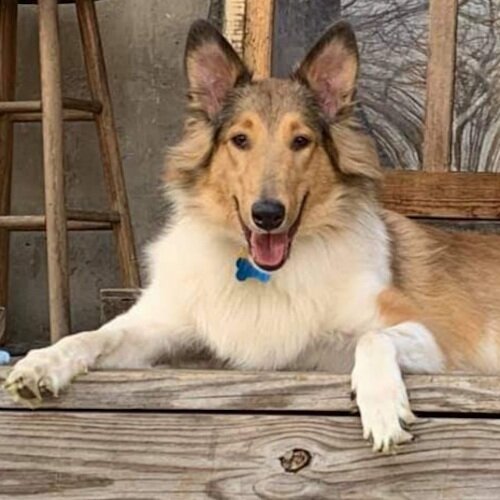Collie Information
Collies make wonderful companions! Learn more about the unique qualities of this breed by clicking on any of the topics below!
Grooming a Collie or Sheltie
Collies, especially rough Collies, require regular grooming to keep their fur from matting. The following videos walk you through the steps of keeping your Collie happy, healthy and beautiful!
Collie Types and Colors
Throughout our website, you may see mention of several different types of Collies, as well as different colors or markings. There are two main types of Collies: Rough and Smooth, although there are others.
As many people use Lassie as a point of reference when they think “Collie”, Rough Collies are probably the more commonly recognized of the two. Both types of Collies are known for their sweet temperaments, loyalty, and their high intelligence. They are easily trained and, as herding dogs, are often wonderful, protective companions to children.
The main difference between the two is the length and thickness of their coats … Rough Collies have a long coat of hair, while Smooth Collies have two short layers.
Learn more about smooth Collies.
Markings
There are four general colors/markings of Collies. All four are attributes of both the Smooth and the Rough types of Collies.
Sable— Sable is a brownish color that can range from a very light golden color to a very dark reddish-brown.
Tri-Color — Just as it sounds. Tri-color Collies have three different colors in their coat: black, white, and tan/brown.
Blue Merle — Blue Merle is used to describing the markings of a silvery gray dog (it sometimes almost looks spotted), usually mixed with white, black, or brown.
Sable Merle — The Sable Merle is used to describe a dog that is generally Sable in marking, but has blue or “merled” eyes.
Collie Resources by the Education Committee of The Collie Club of America
This PDF by the Collie Club of America provides collie specific resources such as books, training, websites and more. To view, please click here.
Please note that to view this document, you will need Adobe Acrobat Reader. If you do not already have this installed on your computer, please click here to download it for free.
Collie Clubs and Associations
Collie Drug Sensitivity – MDR1
Here is a list of drugs that could affect sensitive Collies*
domperidone
paclitaxel
mitoxantrone
etoposide
rifampicin
morphine
Collies and some other breeds may possess a mutation called MDRI that affects how they respond to certain medicines. Use of these drugs in a Collie that carries this mutation can cause serious neurological issues or death. MDR1 is the abbreviated name of the gene called Multi-Drug Resistance 1.
This mutation and drug sensitivity is something you need to make sure your vet is aware of when they are prescribing medications. If there is any question, ask your vet to test your dog to see if they carry this mutation prior to any medical procedures or before prescribing certain drugs.
Here is a list of drugs known to affect sensitive Collies:
Antiparasitic agents: ivermectin, milbemycin oxime, selecamectin, moxidectin, abamectin
Gastrointestinal agents: loperamide (over-the-counter antidiarrheal agents, e.g., Imodium AD, some formulas of Kaopectate and Pepto Bismol)
Anticancer agents: oxorubicin, vincristine, vinblastine
Immunosuppressive agents: Cyclosporin, cyclosporin A, tacrolimus
Cardiac agents: digoxin, quinidine
Antibiotics: erythromycin, grepafloxacin
Steroids: dexamethasone, hydrocortisone
Tranquilizers: acepromazine
Pain control: butorphanol, ondansetron
To test your collie for drug sensitivity, visit http://www.vetmed.wsu.edu/depts-VCPL
For a full summary of information on drug sensitivity in collies, visit: http://www.awca.net/drug.htm
Download a PDF of the full list, and ask your vet to save it in your dog’s file.
Reference
Technical Description of MRDI:
There is a mutation at the MDR1 locus (mdr1-1?) that causes a defect in the blood-brain barrier, mediated by P-glycoprotein, an ATP-dependent drug transporter that moves a broad spectrum of substrates across several tissue borders throughout the body.
Drug sensitivity status, explained:
MUTANT/MUTANT:
Collies that are homozygous for the mdr1-1? mutation are highly sensitive to the drugs listed and may suffer severe or even fatal neurotoxicoses when the drugs are administered at normal therapeutic doses (except for the monthly treatments for heartworm and fleas, which are safe). Reactions include the rapid onset of respiratory failure; respirator support may be necessary as a life saving measure.
NORMAL/MUTANT:
Collies that are heterozygous at the MDR1 locus may still show sensitivity to the drugs listed, suffering neurological symptoms even at normal therapeutic doses. Therefore these drugs should be administered with caution and the dog’s reaction closely monitored. Use of the drug should be terminated immediately if neurological signs are suspected or present.
NORMAL/NORMAL:
Collies that are homozygous normal are no more sensitive to these drugs than any other dog and normal therapeutic doses can be administered.
UNKNOWN:
Only 20% of collies are NORMAL/NORMAL. One in three collies is MUTANT/MUTANT on average; the rate of homozygous mutants may be higher in families of related collies. Therefore, collies of unknown status must be treated as if they are sensitive to these drugs
*Drugs that are P-glycoprotein substrates can build up dangerous levels in the brains of genetically sensitive Collies
A Brief History of the Collie
A Collie is a breed of dog that was originally used for herding and guarding flocks of sheep in Scotland. Today, there are two standard types of Collie: rough (long haired) and smooth (short haired), and each can display a range of four colors (sable & white, tri-color, white, and blue merle). While the breed is instantly recognizable today thanks to Lassie, they originally looked quite different from the Collies we see today.
There are several known varieties of early Collies. The Scottish Collie was a larger dog, closer to what we know today, though more aggressive in its herding. The Welsh Collie was smaller and often domesticated as a pet in addition to its herding duties. The dogs eventually made their way to the English markets, where they were bred. There is much dispute as to the exact origin of the Collie as we know it (even the Collie Club of America admits there are some obscurities in their history), but it is thought they might have been bred with the Borzoi (a Russian Wolfhound) which would explain the shape of the head. It is unknown how much of the Borzoi actually made it into the “standard” Collie breed.
Dog ownership started to rise after the industrial revolution. Queen Victoria fell in love with the breed, and brought one in as a pet – starting the craze for Collies as a house pet. Rough Collies were slowly replaced by Border Collies as the main herding dog in the UK, though they’ve continued to flourish as “working” dogs in other countries around the world.
In 1860, Collies made their first appearance in the show ring, but were then smaller dogs with a shorter, thinner coat. When we think of a Collie, we usually think of a rather large dog with long fur – indeed, most weigh in at somewhere between 45 and 90 pounds, and are up to 26” tall at the shoulder. But early Collies were much smaller, only weighing between 25 and 40 pounds. Their long, thick coats are also likely an eventual adaptation to colder climates as this was not considered a trait of early Collies, either.
Collies made it to the United States for the first time in 1879, brought over by Americans to be show dogs. Due to their loyalty, grace and temperament, they were an instant success. They have continued to be an American favorite.
Further reading
The Collie Club of America
American Kennel Club
American Working Collie Association






